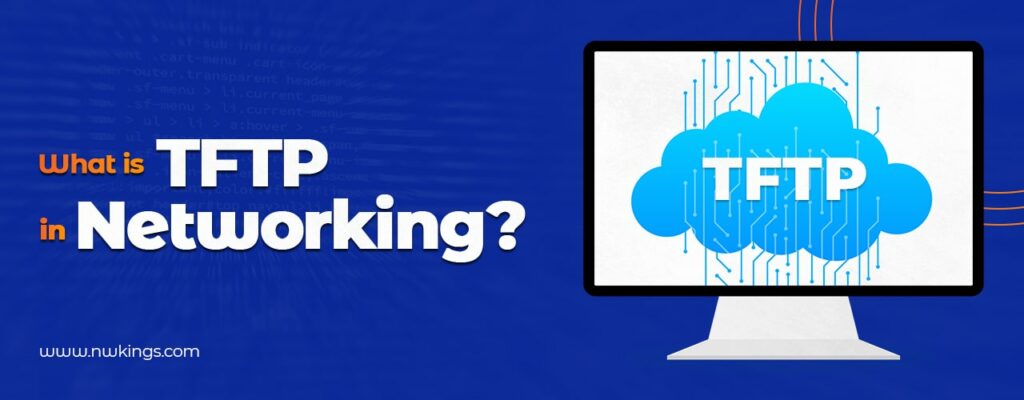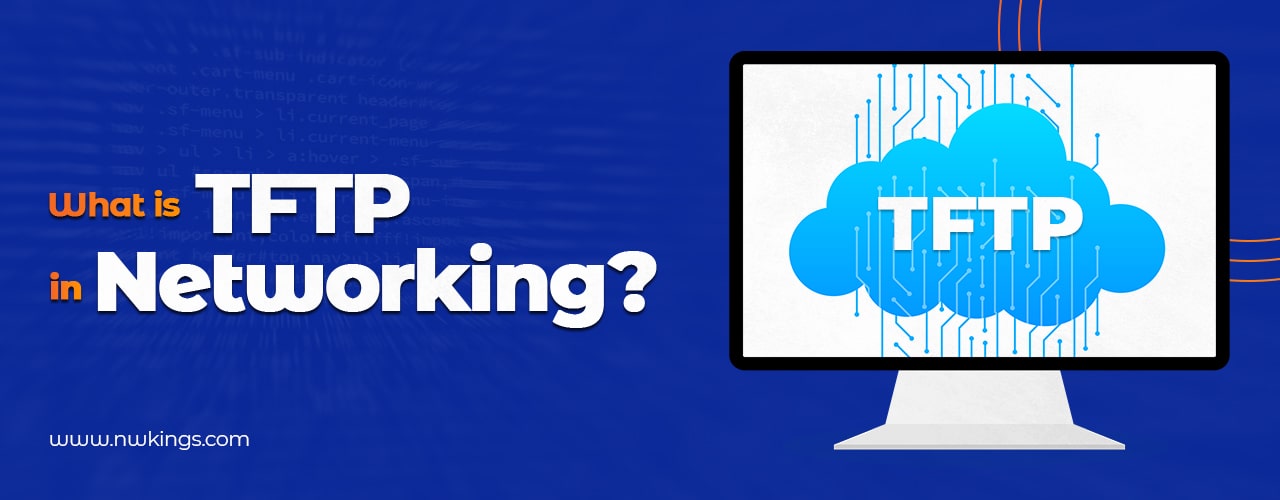
TFTP is a file transfer protocol that is commonly used in computer networks. It is a simple protocol that is based on the UDP protocol and is used to transfer files between hosts on a network. I recommend you first go through the FTP protocol before you start learning about the TFTP protocol in detail.
TFTP is a popular protocol because it is easy to use and does not require any authentication. However, the TFTP protocol has some limitations, such as the fact that it can only transfer files that are less than 4 MB in size.
In this blog, we will give you a brief introduction to the TFTP protocol in CCNA Course. We will also discuss the basics of how it works and some of the benefits and use cases of TFTP.
In the previous blog of our CCNA 200-301 series , we talked about the CDP vs LLDP. I recommend you go through it before you jump to this blog.
What is TFTP?
TFTP stands for Trivial File Transfer Protocol. It is a simplified version of the File Transfer Protocol (FTP). This protocol is mainly used to transfer files between network devices, such as computers and routers. It is based on the UDP protocol and is used in networks where reliability and authentication are not important.
Trivial File Transfer Protocol (TFTP) is a simple lock-step File Transfer Protocol that allows a client to get or put a file onto or from a remote host. One of its primary uses is in the early stages of nodes in computer networks booting from a localized file server. TFTP has been used for this application because it’s simple to implement. The protocol has undergone minimal standardization, and therefore many implementations are incompatible with each other.
It is a very simple protocol that only supports basic read and write operations. It does not provide user authentication, encryption or compression of data.
What is a TFTP Server and How Does TFTP Works?
A TFTP server is typically used to boot diskless workstations, download configuration files to network-aware printers, or to start the installation process for some operating systems. It is also used by some bootloaders, such as PXELINUX.
The TFTP also works on a client-server model. TFTP can fit inside small boot ROMs (Read Only Memory) because of its small size. It is a lightweight fast file transfer protocol, all thanks to the ASCII (American Standard Code for Information Interchange) and binary modes.
The data is sent block-by-block through TFTP and the block sizes are split into 512 bytes each. The client and server communication takes place in the following steps:
- It establishes a connection with the client by using port 69 as it uses User Datagram Protocol (UDP) to communicate the files.
- The client requests RRQ (Read Request) or WRQ (Write Request) after a well-established connection is formed. An RRQ is requested when the client just wants to read a file. It sends a WRQ request when it wants to write a file from the server.
- These files are transferred in the form of packets or blocks.
- Each packet is split up into 512 bytes.
- Since the TFTP cannot rely on UDP to ensure file delivery, the server waits for the client to get an acknowledgment that the file has been received. This happens when the packet has been communicated from the server to the client.
- It is only after the acknowledgment is received that the server sends the next packet as 512 bytes.
- This process occurs until the last packet is communicated to the client.
What if a packet is not received in a specified time?
If the server does not receive an acknowledgment from the client if the packet is received or not, the server pushes the packet again until it is acknowledged by the client. The block/packet is always sent with a size of less than 512 bytes so that the client knows that it is the last packet.
If all the packets that have to be sent can be divided into equal parts of 512 bytes, the server sends the last block of a size of 0 bytes to signal the client that it is the last block.
The Three Modes of Transfer
TFTP has three different modes of operation. These modes are:
- Read
- Write
- Data
In the read mode, the client device requests an existing file from the server.
In the write mode, the client device sends a new file to the server.
And in the data mode, the client device receives a response after completing the data transfer.
The Major Benefits of TFTP
There are a few major benefits of using TFTP in a network. Some of them are as follows:
- The first is that it is a very simple protocol and is easy to configure. This makes it ideal for networks with limited resources, such as small home networks.
- The second benefit is that it does not require authentication or encryption. This makes it faster to transfer files and reduces the likelihood that the data being transferred will be compromised.
- Finally, TFTP can transfer files of any size, which makes it very convenient.
The Various Use Cases for TFTP
TFTP can be used in a variety of scenarios. It is commonly used in networks to transfer files between network devices, such as routers and computers. It is also often used to transfer configuration files for network devices. In addition, TFTP can be used to update the firmware on network devices or to back up configuration files. It is also sometimes used to transfer disk images or firmware files for embedded devices.
TFTP in the Modern Era
In recent years, the usage of TFTP has declined as other protocols, such as SSH and SCP, have become more popular. This is because these newer protocols offer more features and security.
However, TFTP is still a useful protocol supported by many network devices. Furthermore, its simplicity and lack of authentication make it ideal for small networks that do not require a powerful security protocol.
Conclusion
TFTP is a simple and popular protocol that is used to transfer files between devices on a network. It is based on the UDP protocol and is easy to configure.
The protocol also offers some major benefits, such as the fact that it does not require authentication, encryption, or compression.
In addition, TFTP has a wide range of use cases, such as transferring configuration files, updating firmware, backing up data, and transferring disk images. Despite the rise of more secure protocols, TFTP remains a useful protocol in many networks and is still widely used.


